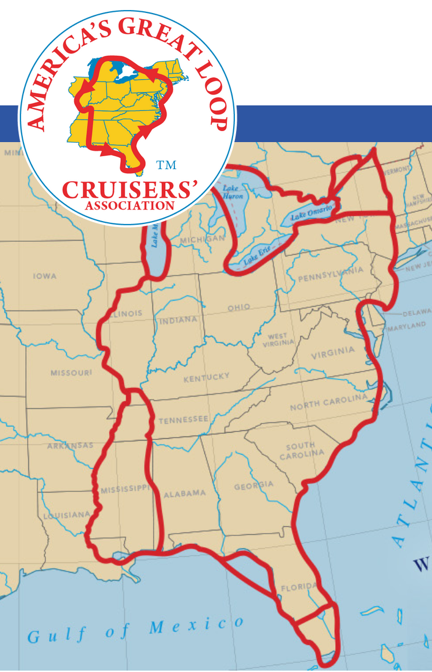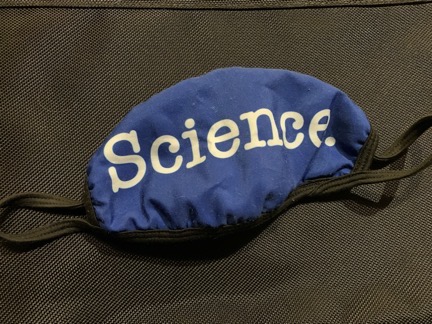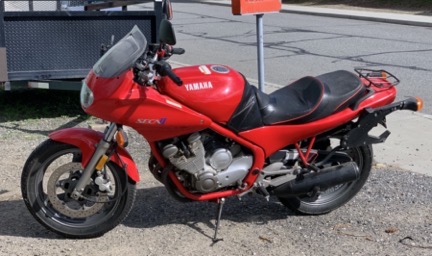There’s no use denying that it’s time.
Yesterday, I listed my motorcycle for sale on Craig’s list.

Here’s my bike, with the bags removed, parked in front of Bob’s house.
It’s a 1993 Yamaha Seca II that I bought brand new in 1992. I vividly recall the day I bought it in Paramus, NJ. I was still riding my first bike, a 1981 (I think) Honda CB 400 Hawk. I’d gone to Americade in Lake George, NY, with my future wasband and the sport touring motorcycle club we rode with and had test ridden the Seca II. It had more power and was sportier than the Hawk. I decided to upgrade and went to the Yamaha dealer in Paramus. I did the paperwork for the bike and then went next door to the BMW car dealer with my future wasband, who was a big BMW fan. They had a new 1991 (I think) K65 (I think) parked in the lobby area. He bought it. We showed up a week or two later at a club event, each riding brand new bikes.
Thanks for the Memories
Other Motorcycling Posts
I started this blog in 2003, which is
after my primary motorcycling days. But I do have a few posts (with photos) here about motorcycling, if you’d like to read more:
I have a lot of really good memories tied up in that bike. I bought and rode it at a time in my life when I was in a good relationship with a man who still knew how to laugh and have fun. A man who knew how to say yes instead of making excuses to say no.
We took our bikes on a motorcycle camping trip down Skyline Drive and the Blue Ridge Parkway, all the way down to Georgia, then rode up the Outer Banks, right after a hurricane. It was an incredible trip — one of the best in my life.
We also took our bikes up to Lake George for Americade trips with the club and other long rides in New Jersey and New York. It was on a trip up to the Finger Lakes that I found the top end of the bike — 110 mph, if you’re curious — on a country road and began thinking about more power. I bought my 1996 Ducati 900 SSCR not long afterward.
But I kept this bike. It had the hard luggage and the comfortable seat. It would be my “touring” bike. Or so I thought.
We moved to Arizona and did a lot less riding. I bought horses and rode out in the desert. I bought a Jeep (which I still have) and drove that out in the desert. I learned to fly and bought a helicopter. There just didn’t seem to be time — or a point, I guess — to ride to the same old places, over and over. The magic was gone.
When I packed up my Arizona life to move to Washington, the Ducati was the first thing to go. I rarely rode — I certainly didn’t need two bikes. Besides, the Yamaha was already up in Washington, where I’d had it shipped a year or two before. I was tired of driving a truck all summer during cherry season so I’d had the bike shipped someplace where I would want to ride it. And I did — I rode more in Washington than I did in Arizona.
Time went on. I did a trip to Friday Harbor with my friend Bob — me on that Yamaha and him on his big old Moto Guzzi. He rode like a Harley guy, slow and ponderously — not at all like the sport touring club members who had helped me find my bike’s top end all those years ago. I think I frightened him. Occasionally, I’d take it out on a ride to Leavenworth or Lake Wenatchee or Silver Falls up the Entiat River. But then I just stopped riding it.
I was busy with other things.
Too Much Stuff
As anyone who has glimpsed the interior of my 2880 square foot garage can tell you, I have a lot of stuff. Too much, probably.
Owning motor vehicles comes with a cost: maintenance. Even if you don’t use them, maintenance is required. In fact, I’d venture to say that more maintenance is required per hour of use if you seldom use them than if you use them often.
My motorcycle became a perfect example of this. Because I didn’t use it, the crap they put in gasoline these days would foul the carburetors and cause all kinds of problem. Tires and hoses get dry rot and crack. Dust accumulates. Lubed chains get clogged with dirt. Batteries die.
After not riding for a few years, I took the bike to the local Yamaha dealer to get it running again. I rode it a few times and parked it for another year. One day I charged up the battery and started it up, only to have fuel spew all over the ground. I covered it back up and left it for another two years. I stopped registering and insuring it. There seemed to be no point.
I had my hands full using and maintaining my other vehicles. The Yamaha was neglected and ignored.
Downsizing Means Letting Things Go
I had a kind of epiphany this winter when I was traveling. I think I have to thank my friend Bill for that. He lives a simple, mobile life and seems very happy. While I’m happy in my home and have no desire to give it up, he helped me realize that I’m probably at the point where I have too much crap in my life. I’d be happier if I could make things simpler.
And, for me, that means getting rid of the stuff I don’t need or want.
Let’s face it: I’m not getting any younger. I’m 59 now and starting to think seriously about retirement. I’m already semi-retired, with real work (my flying business) only a few months out of the year and busy work (my jewelry business) off and on for the rest of the year. I have big plans for my retirement years and they definitely do not include a bunch of stuff I have. Why not get rid of it now?
With that in mind, I decided that the motorcycle would be the first thing to go.
My friend Bob — the Moto Guzzi guy — came by and helped me load the bike onto a trailer so I could bring it to a repair shop in town. They put about $700 of work into the carburetor (again) and a new battery. That got it running pretty good.
Yesterday, I picked it up and rode it to Bob’s house. He’d very graciously offered to sell it for me at his house, which is a lot easier to get to than mine. He has a garage to store it in and won’t take crap from potential buyers.
That 5-mile ride — my first time on a motorcycle in at least 4 years — brought back a flood of memories. Accelerating away from traffic, gliding around curves. Feeling the power of the bike beneath me, feeing it respond to the throttle twist and pressure on the brakes. I seemed to flash back to Sunday rides in Harriman State Park or out to the Delaware Water Gap. To trips where I could feel the wind against me, sense the subtle changes in temperature, smell the aromas of things I passed.
God, how I loved riding!
But I need to be honest with myself: if I keep it I will not ride it regularly. As I age, my reflexes will deteriorate. If I don’t ride regularly, my skills will decline — as I’m sure they already have. Poorer reflexes and skills are likely to get me killed on one of the rare instances I do decide to ride it. And then there’s the maintenance of keeping it when I don’t ride it: battery tending and carburetor repairs. Ugh.
So it’s best to just let it go.
Let go of the object so many good memories are tied to. Let go of a piece of my past that I really wish I could cling to forever.
It’s hard not to cry while typing this.
In Bob’s Hands
Anyway, I brought it and its hard luggage and the big plastic box labeled “Motorcycle Stuff” to Bob’s house. I discovered that I had not one but three motorcycle covers — two of which Bob will keep for his bikes — and not one but two tank bags. I also had two helmets (and will keep one of them in case Bob ever wants to take me riding). It’ll all go in a package.
I’ll admit that I priced it high. The bike only has 22,000 miles on it and is in very good condition with all those extras. But the way I see it, if I can’t get a decent amount of money for it, why sell it? I’m not desperate for money. Besides, it’s spring in Washington, and riding weather is upon us. It would make a great bike for commuting to work or taking a trip. Even the fix-it place said there’s a high demand for used bikes right now.
It’s in Bob’s hands. I know he’ll do a great job finding a buyer for it.
Meanwhile, it’s both sad and nice to have the space the motorcycle and its box of accessories occupied available in my garage.
Letting Go
I realize now that letting go of the things you cling to for emotional reasons is part of getting older and winding down. I think I’ve been in denial for a long time about my stage in life, but letting go of my motorcycle has helped me come to terms with it.
For my whole life, I’ve been building up skills and knowledge and wealth and possessions. It’s part of a cycle that I suspect was ingrained in me from my childhood. But the cycle has another part that I wasn’t prepared for: the winding down. That’s what I’m facing now.
Back in 2013, my godfather, Jackie, died. He was single, in his 80s (I think), and, in his later years, had become a bit of a hoarder. My mother and her first cousin were his next of kin and were tasked with getting his affairs closed up. It was a mess and a lot of work for them.
I also recall when my wasband’s dad passed away suddenly and his family — wife and three adult offspring — were tasked with clearing out the stuff he’d stored in the basement. They used a dumpster.
The way I see it, we should all be tidying up our own affairs as we age to make things a bit easier for ourselves while we’re alive and our next of kin when we die. The older we get, the less stuff we should have.
Downsizing is, in a way, admission that we’re getting old. And while I’m not “old” yet, I’m undeniably getting there. It’s time for the downsizing to begin.
And that’s why I’m preparing to let things go.






